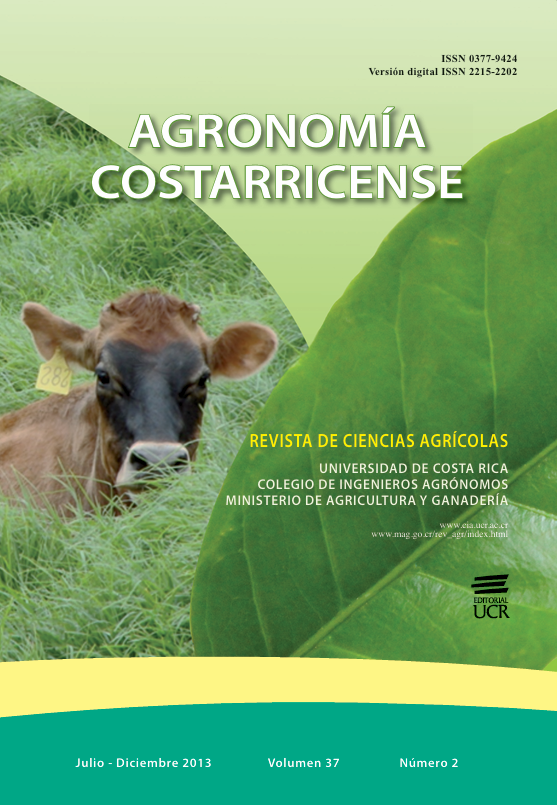Abstract
The effect of nitrogen content, the secondary compounds (tannin and proanthocyanidin) content, the dry matter content of 4 clones, and the different developmental stages of macadamia nuts, on the abundance of Gymnandrosoma aurantianum, was studied. Nitrogen content differed between clones and the stages of development of the nuts, being highest in the most tolerant clones 508>660>344>246. Highest dry matter contents were found in the tolerant clones, 508 and 660, and in the outer layer, than in the susceptible clones 246 and 344 and in the inner layers (2 and 3). Proanthocyanidin content was highest in layer 2 of clones 508 and 660 than in clones 246 and 344. Results show that food quality affects the performance of nutborer larvae, where the larvae have to overcome first a physical barrier, followed by a chemical barrier, to be able to feed on macadamia nuts.References
ATHEY L.A., CONNOR E.F. 1989. The relationship between foliar nitrogen content and feeding by Odonata dorsalis Thun. on Robinia pseudoacacia L. Oecologia 79:390-394.
BERNAL M. 2004. La macadamia, alternativa de diversificación en el país. Dirección de Mercadeo y Agroindustria, Servicio de Información, Consejo Nacional de Producción (CNP). Consultado agosto 2012. Disponible en: http://www.mercanet.cnp.go.cr
BLANCO H. 1994. The biology and ecology of the macadamia nutborer Ecdytolopha torticornis in Costa Rica. PhD Thesis, University of Edinburgh, Scotland. 132 p.
BLANCO H., VILLALOBOS R., WATT A.D., COSENS D. 1997. Efecto del manejo de malezas en macadamia sobre la población del barrenador de la nuez Ecdytolopha torticornis Meyrick (Lepidoptera: Tortricidae). Agronomía Mesoamericana 8(2):96-100.
BLANCO H., WATT A.D., COSENS D. 1993. Ciclo de vida y comportamiento de oviposición de Ecdytolopha torticornis (Lepidoptera: Tortricidae) barrenador de la nuez de macadamia. Revista Manejo Integrado de Plagas 29:36-39.
BLANCO H., WATT A.D., COSENS D. 2007. The effect of predators on the population dynamics of Ecdytolopha torticornis Meyrick (Lepidoptera:Tortricidae). Agronomía Costarricense 31(1):33-39.
BLANCO H., WATT A.D., COSENS D. 2009. The effect of parasitism on the population dynamics of Gymnandrosoma torticornis (Lepidoptera:Tortricidae). Revista Biología Tropical 57(4):1245-1252.
COLEY P.D. 1983. Herbivory and defensive characteristics of tree species in a lowland tropical forest. Ecological Monographs 53(2):209-233.
DAANE K.M., JOHNSON R.S., MICHAILIDES T.J., CRISOSTO C.H., DLOTT J.W., RAMIREZ H.T., YOKOTA G.Y., MORGAN D.P. 1995. Excess nitrogen raises nectarine susceptibility to disease and insects. California Agriculture 49(4):13-18.
DIXON R.A., XIE D.Y., SHARMA S.B. 2005. Proanthocyanidins—a final frontier in flavonoid research? New phytologist 165(1):9-28.
DWOMOH E.A., OFORI-FRIMPONG K., AFRIFA A.A., APPIAH M.R. 2008. Effects of fertilizar on nitrogen contents of berries of three coffee clones and berry infestation by the coffee berry borer, Hypothenemus hampei (Ferr.) (Coleoptera: Scolytidae). African Journal of Agricultural Research 3(2):111-114.
GROENTEMAN R., GUERSHON M., COLL M. 2006. Effects of leaf nitrogen content on oviposition site selection, offspring performance, and intraspecific interactions in an omnivorous bug. Ecological Entomology 31:155-161.
IHEAGWAM E.U. 1981. The relationship between weight of insect, age, hardness, and nitrogen content of cabbage leaves and fecundity of the cabbage whitefly, Aleyrides brassicae Wlk. (Homoptera:Aleyrodidae). Zeitschrift fur Angewandte Entomologie 91:349-354.
MATTSON W.J. 1980. Herbivory in relation to plant nitrogen content. Annual Review of Ecology and Systematics 11:119-161.
MELLWAY R.D., CONSTABEL C.P. 2009. Metabolic engineering and potential functions of proanthocyanidines in poplar. Plant Signaliong and Behaviour 4:8, 790-792.
MORAVVEY GH.H., HATEFI S. 2008. Role of nitrogen content of pea (Pisum sativum L.) on pea aphid (Acyrthosiphon pisum Harris) establishment. Caspian Journal of Environmental Science 6(2):113-131.
MÜLLER L. 1961. Un aparato micro-Kjeldhal para análisis rutinarios rápidos de materiales vegetales. Turrialba 11(1):17-25.
NAGAO M.A. 2011. Farm and Forestry Production and Marketing Profile for Macadamia Nut (Macadamia integrifolia and M. tetraphylla). Speciality Crops for Pacific Island Agroforestry. Permanent Agriculture Resource (PAR) Holualoa, Hawaii. 19 p.
OSIER T.L., LINDROTH R.L. 2001. Effects of genotype, nutrient availability and defoliation, on aspen phytochemistry and insect performance. Journal of Chemical Ecology 27(7):1289-1313.
REED J.D., HORVATH P.J., ALLEN M.S. VAN SOEST P.J. 1985. Gravimetric determination of soluble phenolics including tannins from leaves by precipitation with trivalent ytterbium. Journal Science Food Agriculture 36:255-261.
RHOADES D.F. 1983. Herbivore population dynamics and plant chemistry, pp. 155-220. In: R.F. Denno and M.S. McClure (eds.). Variable plants and herbivores in natural and managed systems. New York, Academic Press.
RITTNER U., REED J.D. 1992. Phenolics and in-vitro degradability of protein and fiber in West African Browse. Journal Science Food Agriculture 58:21-28.
SAS INSTITUTE. 1985. SAS user’s guide: statistics, version 5,1. Cary North Carolina, SAS Institute.
SOUTHWOOD T.R.E. 1972. The insect/plant relationship – an evolutionary perspective. In: Insect/Plant Relationship (van Emden H.F., ed.). Symposium. Review of Entomological Society, London 6:3-30.
TABASHNIK B.E. 1982. Response of pest and non-pest Colias butterfly larvae to intraspecific variation in leaf nitrogen and water content. Oecologia 55:389-394.
WANG J.J., TSAI J.H., BROSCHAT TK. 2006. Effect of nitrogen fertilization of corn on the development, survivorship, fecundity and body weight of Peregrinus maidis (Homoptera:Delphacidae). Journal of Applied Entomology 130(1):20-25.
WATT A.D. 1990. The consequences of natural, stressedinduced and damaged-induced differences in tree foliage on the population dynamics of the pine beauty moth, pp. 157-168. In: A.D. Watt, S.R. Leather, M. Hunter and N.A.C. Kidd (eds.). Population dynamics of forests insects. Andover, Hampshire, Intercept.
Wikipedia . 2009. Macadamia. Consultado 17 agosto 2012. Disponible en: http://en.wikipedia.org


